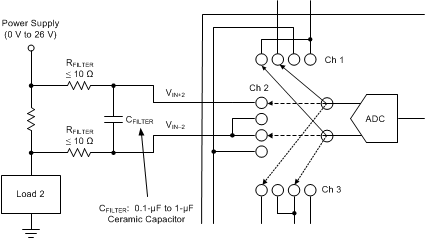SBOS776C March 2016 – March 2021 INA3221-Q1
PRODUCTION DATA
- 1 Features
- 2 Applications
- 3 Description
- 4 Revision History
- 5 Device Comparison Table
- 6 Pin Configuration and Functions
- 7 Specifications
-
8 Detailed Description
- 8.1 Overview
- 8.2 Functional Block Diagram
- 8.3 Feature Description
- 8.4 Device Functional Modes
- 8.5 Programming
- 8.6
Register Maps
- 8.6.1 Summary of Register Set
- 8.6.2
Register Descriptions
- 8.6.2.1 Configuration Register (address = 00h) [reset = 7127h]
- 8.6.2.2 Channel-1 Shunt-Voltage Register (address = 01h), [reset = 00h]
- 8.6.2.3 Channel-1 Bus-Voltage Register (address = 02h) [reset = 00h]
- 8.6.2.4 Channel-2 Shunt-Voltage Register (address = 03h) [reset = 00h]
- 8.6.2.5 Channel-2 Bus-Voltage Register (address = 04h) [reset = 00h]
- 8.6.2.6 Channel-3 Shunt-Voltage Register (address = 05h) [reset = 00h]
- 8.6.2.7 Channel-3 Bus-Voltage Register (address = 06h) [reset = 00h]
- 8.6.2.8 Channel-1 Critical-Alert Limit Register (address = 07h) [reset = 7FF8h]
- 8.6.2.9 Warning-Alert Channel-1 Limit Register (address = 08h) [reset = 7FF8h]
- 8.6.2.10 Channel-2 Critical-Alert Limit Register (address = 09h) [reset = 7FF8h]
- 8.6.2.11 Channel-2 Warning-Alert Limit Register (address = 0Ah) [reset = 7FF8h]
- 8.6.2.12 Channel-3 Critical-Alert Limit Register (address = 0Bh) [reset = 7FF8h]
- 8.6.2.13 Channel-3 Warning-Alert Limit Register (address = 0Ch) [reset = 7FF8h]
- 8.6.2.14 Shunt-Voltage Sum Register (address = 0Dh) [reset = 00h]
- 8.6.2.15 Shunt-Voltage Sum-Limit Register (address = 0Eh) [reset = 7FFEh]
- 8.6.2.16 Mask/Enable Register (address = 0Fh) [reset = 0002h]
- 8.6.2.17 Power-Valid Upper-Limit Register (address = 10h) [reset = 2710h]
- 8.6.2.18 Power-Valid Lower-Limit Register (address = 11h) [reset = 2328h]
- 8.6.2.19 Manufacturer ID Register (address = FEh) [reset = 5449h]
- 8.6.2.20 Die ID Register (address = FFh) [reset = 3220]
- 9 Application and Implementation
- 10Power Supply Recommendations
- 11Layout
- 12Device and Documentation Support
- 13Mechanical, Packaging, and Orderable Information
Package Options
Mechanical Data (Package|Pins)
- RGV|16
Thermal pad, mechanical data (Package|Pins)
Orderable Information
8.4.3 Filtering and Input Considerations
Measuring current is often noisy, and such noise can be difficult to define. The INA3221-Q1 offers several filtering options by allowing conversion times and the number of averages to be selected independently in the Configuration register. The conversion times can be set independently for the shunt- and bus-voltage measurements as well, for added flexibility in configuring power-supply bus monitoring.
The internal ADC is based on a delta-sigma (ΔΣ) front-end with a 500-kHz (±30%) typical sampling rate. This architecture has good inherent noise rejection; however, transients that occur at or very close to the sampling-rate harmonics can cause problems. These transient signals are at 1 MHz and higher; therefore, the signals are managed by incorporating filtering at the INA3221-Q1 input. High-frequency signals allow for the use of low-value series resistors on the filter, with negligible effects on measurement accuracy. In general, filtering the INA3221-Q1 input is only necessary if there are transients at exact harmonics of the 500-kHz (±30%) sampling rate that are greater than 1 MHz. Filter using the lowest-possible series resistance (typically 10 Ω or less) and a ceramic capacitor. Recommended capacitor values are 0.1 μF to 1.0 μF. Figure 8-8 shows the INA3221-Q1 with an additional filter added at the input.
 Figure 8-8 INA3221-Q1 With Input Filtering
Figure 8-8 INA3221-Q1 With Input FilteringThe INA3221-Q1 inputs are specified to tolerate 26 V across the inputs. However, overload conditions are another consideration for the INA3221-Q1 inputs. For example, a large differential-input scenario might be a short to ground on the load side of the shunt. This type of event results in the full power-supply voltage applied across the shunt, if supported by the power supply or energy-storage capacitors. Keep in mind that removing a short to ground may result in inductive kickbacks that can exceed the 26-V differential and common-mode rating of the INA3221-Q1. Inductive kickback voltages are best controlled by zener-type transient-absorbing devices (commonly called transzorbs) combined with sufficient energy-storage capacitance.
In applications that do not have large energy-storage electrolytic capacitors on one or both sides of the shunt, an input overstress condition can result from an excessive dV/dt of the voltage applied to the input. A hard physical short is the most likely cause of this event, particularly in applications without large electrolytic capacitors present. This problem occurs because an excessive dV/dt can activate the INA3221-Q1 ESD protection in systems where large currents are available. Testing has demonstrated that the addition of 10-Ω resistors in series with each INA3221-Q1 input sufficiently protects the inputs against this dV/dt failure up to the 26-V device rating. Selecting these resistors in the range noted has minimal effect on accuracy.